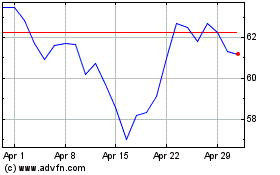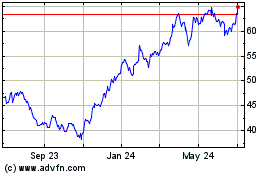Jet.com Abandons $50 Membership Fee
October 07 2015 - 2:40PM
Dow Jones News
Jet.com Inc. is already abandoning the main business model
behind its new discount-shopping site, a surprising turnabout for
what many viewed as the most promising challenge to Amazon.com Inc.
in years.
The Hoboken, N.J., startup said Wednesday it will do away with
the required $50 annual membership fee less than three months after
launching the site. Jet had insisted the fee would stand as its
sole source of profits, giving back commissions it collects on the
sale of merchandise to customers in the form of lower prices.
The move casts doubt on the viability of one of this year's
most-hyped startups, and suggests Jet had trouble signing up
customers through free trials. Even before it opened the site to
the public in July, Jet had raised $225 million in capital from
investors including Goldman Sachs Group Inc. and Google Inc.'s
Google Ventures.
Without the membership fees, it isn't clear how Jet will sustain
lower prices than Amazon's—its key pitch to customers—while also
funding a massive advertising campaign. Jet projected it wouldn't
reach profitability until 2020.
Jet's founder, Marc Lore, who also created Diapers.com and later
sold that company to Amazon, liked to say his new site would be
akin to an online Costco.
"We're saying we're not going to make a profit, we'll make a
profit from membership," said Mr. Lore in an interview in July for
a page-one story in The Wall Street Journal. "So we take
commissions we get from merchants and it comes off the price.
[Amazon must] keep the commissions as a profit. That's the
difference."
Mr. Lore declined to comment for this story. In a blog post
announcing the removal of the membership fee, Mr. Lore said Jet
would offer a year of free shipping for early members, with no
minimum order size, adding to its expenses.
Investors were drawn to Mr. Lore's unusual business model. He
promised prices up to 15% lower than Amazon's by plowing the
commissions back into prices, as well as rewarding customers for
combining orders so that vendors could cut shipping prices.
Unlike Amazon, Jet is a pure marketplace holding very little
inventory and relying instead on brands, manufacturers and
resellers who maintain their own warehouses and fulfillment
networks.
Jet handed out free memberships, offering trial periods of
between three months and one year, meaning very few if any users
had to pay the $50 fee. It plastered the coupon codes on buses,
subway posters and taxi cabs in a projected $100 million marketing
push during the first 12 months from the July launch, adding to
pressure on the company to find a way to make money quickly.
If Mr. Lore had carried through with his original plan, he would
have faced an uphill battle because Jet would need to constantly
add new customers to grow revenue with the membership fees. Every
Jet customer would be just as valuable to the bottom line because
the company wouldn't profit from bigger spenders.
That stands in contrast to Amazon and its $99-per-year Prime
membership, because the Seattle company profits from the
commissions it collects for sales on its site. Amazon can cut
prices through negotiating with suppliers and reducing the cost of
its shipping and delivery network. Revenue for Amazon is on a pace
to reach $100 billion this year.
The move away from a subscription fee means Jet will have to
employ more traditional methods to turn a profit, like keeping a
portion of commissions for itself or charging merchants other fees
like those for preferred placement on the website, a common tactic
among other e-commerce sites. If it keeps more of the commissions
that means it can no longer promise the low prices that is the big
selling point of the site.
The Wall Street Journal learned in July that Jet was using a
tactic to build out its inventory by buying goods from other
companies' sites and shipping them to Jet customers. It is an
expensive proposition because Jet paid the full retail price, as
well as shipping and the cost of returns.
In an analysis at the time, the Journal found that 12 items
among 22 purchased on Jet were shipped by retailers such as
Wal-Mart Stores Inc. and Nordstrom Inc. Jet's prices for the 12
items added up to $275.55, an average discount of about 11% from
the prices Jet paid for those items on other retailers' websites.
Jet's total cost, including estimated shipping and taxes, was
$518.46. As a result, Jet had an overall loss of $242.91 on the 12
items.
Many of the retailers were unaware their merchandise, photos and
product descriptions, in some cases, were being listed on Jet's
site.
Write to Greg Bensinger at greg.bensinger@wsj.com and Rolfe
Winkler at rolfe.winkler@wsj.com
Access Investor Kit for "CitiGroup Inc"
Visit
http://www.companyspotlight.com/partner?cp_code=P479&isin=US1729674242
Subscribe to WSJ: http://online.wsj.com?mod=djnwires
(END) Dow Jones Newswires
October 07, 2015 14:25 ET (18:25 GMT)
Copyright (c) 2015 Dow Jones & Company, Inc.
Citigroup (NYSE:C)
Historical Stock Chart
From Mar 2024 to Apr 2024

Citigroup (NYSE:C)
Historical Stock Chart
From Apr 2023 to Apr 2024
